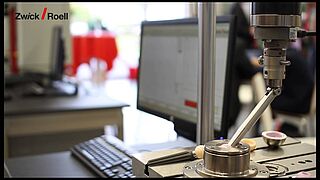ASTM F1820 Disassembly of Acetabular Shell and Liner
The ASTM F1820 standard specifies different test methods for determining the forces for disassembly between the acetabular shell and liner.
Objective & applications Specimens Running a test Video Types of test Requirements Testing systems
ASTM F1820 objective & applications
The ASTM F1820 standard defines a standardized procedure for determining the force required to remove the inlay (liner) from the acetabular shell. This test is of critical importance for the quality assurance and development of hip implants, as it evaluates the mechanical stability and safety of the connection between the liner and the acetabular shell. Manufacturers and research institutions use these tests to compare the performance of different material and design variants and to ensure that they can withstand the high demands of clinical use.
ASTM F1820 specimens and dimensions
The specimens to be tested consist of an acetabular shell with an inserted liner, which was mounted according to the manufacturer's instructions. ASTM F1820 does not define specific dimensions, as these depend on the respective implant size. However, it is important that the test is carried out under realistic conditions in order to obtain representative results.
Running a test according to ASTM F1820
The test procedure includes several steps:
- Clamping of the test specimen: the acetabular shell is secured in a suitable holding device.
- Positioning of the load unit: a cylindrical or conical punch is inserted centrally into the liner.
- Application of force: the punch is axially loaded at a defined speed until the liner is released from the shell.
- Measurement and documentation: The maximum dismantling force is recorded and documented.
The test can be carried out under various conditions, for example in physiological solution or at near-body temperatures, in order to obtain realistic data.
Test types according to ASTM F1820
ASTM F1820 includes several test methods to evaluate the mechanical stability of the connection between the liner and the acetabular shell:
Axial disassembly (push-out) test:
- Determination of the maximum force required to remove the liner axially from the shell.
- An axially acting punch presses on the liner at a constant speed (e.g. 10-50 mm/min) until it is released.
- Shows the basic mechanical stability of the fixation between liner and shell.
Torque-out disassembly test:
- Test of the torsional strength of the liner within the shell.
- A torque-applying device subjects the liner to a defined torsional load while the shell remains secured.
- Simulates the load caused by rotational movements in real joint applications and provides information on the resistance to torsion.
Offset pull-out or lever-out disassembly:
- Simulation of asymmetrical loads to test the behavior of the connection under edge forces.
- A punch does not press centrally onto the liner, but at a defined angle.
- Simulates realistic movement sequences and misloading that can occur in vivo.
Dynamic tests:
- Evaluation of long-term stability through repeated load cycles.
- The acetabular shell is subjected to alternating forces over several thousand to millions of load cycles.
- Allows conclusions to be drawn about the durability of the connection under realistic continuous loads.
ASTM F1820 requirements
ASTM F1820 defines specific requirements for the testing machine, including:
- High-precision force measurement: the testing machine must have an accuracy of at least ±1 % of the maximum test force.
- Uniform, axially aligned application of force: the load must be applied perfectly centered to ensure a realistic load.
- Adjustable load speed: the test speed must be adjustable between 10 mm/min and 50 mm/min.
- Rigid holding device: a specially developed clamping device must ensure reproducible fixation of the acetabular shell.
- Recording the failure mechanisms: in addition to the maximum push-out force, the testing machine must also be able to document deformations and fracture mechanisms.
- Automated data acquisition: the machine should enable precise and continuous recording of all relevant test parameters.
- Repeatability: the testing machine must ensure consistent reproducibility of the results in order to carry out comparative tests reliably.
Testing to ASTM F1820 with ZwickRoell
ZwickRoell offers testing solutions that have been specially developed to meet the ASTM F1820 requirements. The most important advantages:
- High-precision measuring systems: detection of the dismantling force with maximum accuracy.
- Flexibility in test execution: modular, customizable test setups for different implant designs.
- testXpert testing software: user-friendly control and comprehensive data evaluation.
- Individual customizations: development of specific holding devices and test configurations for customer-specific requirements.
- Many years of experience: ZwickRoell is a leading global supplier of materials testing technology and supports customers in medical technology with first-class support and application-optimized solutions.
With a ZwickRoell testing machine, you can ensure that your hip implants meet the highest quality standards and fulfill regulatory requirements.

